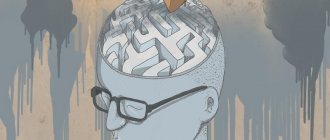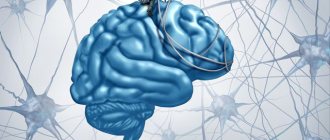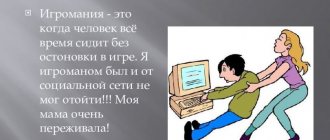Society started talking about such a disease as autism relatively recently.
Autism: what kind of disease is it, how to cope with it, and most importantly, by what signs can it be recognized? Answers to these and many other questions are further in the material.
Autism - what is it?
Autism in Wikipedia and other encyclopedias is defined as a general developmental disorder in which there is a maximum deficit in emotions and communication. Actually, the name of the disease determines its essence and how the disease manifests itself: the meaning of the word “autism” is within oneself. A person suffering from this disease never directs his gestures and speech to the outside world. There is no social meaning in his actions.
At what age does this disease appear? This diagnosis is most often made in children aged 3-5 years and is called RDA , Kanner syndrome . In adolescence and adulthood, the disease manifests itself and, accordingly, is rarely detected.
Autism is expressed differently in adults. Symptoms and treatment of this disease in adulthood depend on the form of the disease. There are external and internal signs of autism in adults. Characteristic symptoms are expressed in facial expressions, gestures, emotions, volume of speech, etc. It is believed that types of autism are both genetic and acquired.
Is this a congenital or acquired disease?
The first signs of autism appear before the age of three.
The disease occurs more often in boys than in girls.
By the time a child enters school, developmental delays, problems with social contacts, and in the emotional sphere are already clearly visible.
From early childhood, such children do not look into the eyes, do not react to the sound of voices, and in severe cases do not distinguish strangers from relatives.
Even at birth, children do not show positive emotions and do not distinguish their mother, while ordinary babies very quickly learn to distinguish their mother from other people and are afraid of strangers.
Autism is now considered a congenital or early-onset mental disorder .
One version is that the mother suffered viral diseases during pregnancy that affect the development of the fetal brain.
In some cases, autism can also be acquired , for example, after suffering trauma.
Causes of autism
The causes of this disease are associated with other diseases, psychiatrists say.
As a rule, autistic children are in good physical health and have no external defects. The brain of sick babies has a normal structure. When talking about how to recognize autistic children, many note that such babies are very attractive in appearance.
In mothers of such children, pregnancy proceeds normally. However, the development of autism is still in some cases associated with the manifestation of other diseases:
- cerebral palsy;
- infection with rubella during pregnancy;
- tuberous sclerosis;
- impaired fat metabolism (the risk of having a baby with autism is greater in obese ).
All of these conditions can have a negative impact on the brain and, as a result, provoke symptoms of autism. There is evidence that genetic disposition plays a role: signs of autism are more likely to appear in people who already have autism in their family. However, what autism is and what the causes of its manifestation are are still not completely clear.
Is it inherited?
If one of the parents suffers from autism, then according to psychiatrists, the risk of having a child with this syndrome is higher.
However, it is not known exactly whether this is due to the transmission of certain genes, or whether social factors and the example of adult behavior play a role.
People with a severe form of autism practically do not marry, but if the form is mild , it is likely that they will start a family and pass on to their children the genes that provoke the onset of the disease.
Read about the rules and meaning of empathic listening here.
An autistic child's perception of the world
Autism in children manifests itself with certain signs. It is generally accepted that this syndrome leads to the fact that the baby cannot combine all the details into a single image.
The disease manifests itself in the fact that the child perceives a person as a “set” of unrelated body parts. The patient hardly distinguishes inanimate objects from animate ones. All external influences - touch, light, sound - provoke an uncomfortable state. The child tries to withdraw inside himself from the world that surrounds him.
Forecast
The prognosis depends on a lot of factors. The following points play a role:
- Age of development of deviation.
- Form of the pathological process. Its variety. Low-functioning forms have initially poorer prospects for recovery.
- Intelligence level.
- Preservation of speech function, development of verbal skills.
- Correction of autism and its nature. Without treatment, the disease will persist for a long time. In adult patients who have not previously received therapy, the likelihood of recovery is significantly lower. The prognosis is relatively negative.
- Tendency to independence.
- Expanding a person’s sphere of interests after therapy.
- Facilitating social communications.
Practice shows that it is almost never possible to immediately assess prospects. Interim results are summed up after complex treatment has been carried out. According to generalized calculations, the probability of achieving stable remission and full functioning in society is about 25%. That is, no more than a quarter of people manage to achieve conditional restoration of basic functions.
As for secondary forms, when the disorder is part of the syndrome. Most psychotic disorders of the schizophrenia spectrum have a poor prognosis. Autization is a natural part of the so-called defect. It persists constantly and gets worse over time without treatment. Brain diseases are not so obvious in terms of prospects.
Symptoms of Autism
Autism in children manifests itself with certain signs. Early childhood autism is a condition that can manifest itself in children at a very early age - both at 1 year and at 2 years old. What is autism in a child, and whether this disease exists, is determined by a specialist. But you can independently figure out what kind of illness a child has and suspect him based on information about the signs of such a condition.
Early signs of autism in a child
This syndrome is characterized by 4 main symptoms. In children with this disease, they can be determined to varying degrees.
Signs of autism in children are:
- impaired social interaction;
- impaired communication;
- stereotypical behavior;
- early symptoms of childhood autism in children under 3 years of age.
Disturbed social interaction
The first signs of autistic children may appear as early as 2 years of age. Symptoms can range from mild when eye-to-eye contact is impaired to more severe when it is completely absent.
The child cannot perceive as a whole the image of the person who is trying to communicate with him. Even in photos and videos, you can recognize that such a baby’s facial expressions do not correspond to the current situation. He does not smile when someone tries to cheer him up, but he can laugh when the reason for this is not clear to anyone close to him. The face of such a baby is mask-like; grimaces appear on it from time to time.
The baby uses gestures only to indicate needs. As a rule, even children under one year of age sharply show interest if they see an interesting object - the baby laughs, points, and demonstrates joyful behavior. The first signs in children under 1 year of age can be suspected if the child does not behave this way. Symptoms of autism in children under one year of age are manifested by the fact that they use a certain gesture, wanting to get something, but do not strive to capture the attention of their parents by including them in their play.
Disturbed social interaction, photo
An autistic person cannot understand other people's emotions. How this symptom manifests itself in a child can be tracked already at an early age. While normal children's brains are designed in such a way that they can easily determine when looking at other people whether they are upset, happy or scared, an autistic child is not capable of this.
The child is not interested in peers. Already at the age of 2, ordinary children strive for company - to play, to meet peers. Signs of autism in 2-year-old children are expressed by the fact that such a child does not participate in games, but is immersed in his own world. Those who want to know how to recognize a child 2 years old and older should simply take a closer look at the company of children: an autistic person is always alone and does not pay attention to others or perceives them as inanimate objects.
The child finds it difficult to play using imagination and social roles. Children 3 years old and even younger play, imagining and inventing role-playing games. For autistic people, symptoms at 3 years old may include not understanding what the social role is in play and not perceiving toys as whole objects. For example, signs of autism in a 3-year-old child may be expressed by the child spinning a car wheel for hours or repeating other actions.
The child does not respond to emotions and communication from the parents. Previously, it was generally accepted that such children did not become emotionally attached to their parents at all. But now scientists have proven that when the mother leaves, such a child at 4 years old and even earlier shows anxiety. If family members are nearby, he seems less obsessive. However, in autism, signs in 4-year-old children are expressed by a lack of reaction to the fact that parents are absent. The autistic person exhibits anxiety, but he does not try to get his parents back.
Broken communication
In children under 5 years of age and later, there is a delay in speech or its complete absence ( mutism ). With this disease, the signs in children 5 years old in speech development are already clearly expressed. The further development of speech is determined by the types of autism in children: if a severe form of the disease is observed, the child may not master speech at all. To indicate his needs, he uses only some words in one form: sleep, eat, etc. The speech that appears is, as a rule, incoherent, not aimed at understanding other people. Such a child can say the same phrase for several hours, which has no meaning. Autistic people talk about themselves in the third person. How to treat such manifestations, and whether their correction is possible, depends on the degree of the disease.
Abnormal speech . When answering a question, such children repeat either the entire phrase or part of it. They may speak too quietly or loudly, or intonate incorrectly. Such a baby does not react if he is called by name.
No “age issues” . Autistic people do not ask their parents many questions about the world around them. If questions do arise, they are monotonous and have no practical significance.
Stereotypical behavior
Gets fixated on one activity. Among the signs of how to identify autism in a child, one should note obsession. A child can spend many hours sorting cubes by color and making a tower. Moreover, it is difficult to return him from this state.
Performs rituals every day. Wikipedia shows that such children feel comfortable only if the environment remains familiar to them. Any changes - a rearrangement in the room, a change in the route for a walk, a different menu - can provoke aggression or pronounced withdrawal.
Repeating meaningless movements many times (manifestation of stereotypy) . Autistic people tend to self-stimulate. This is a repetition of the movements that the child uses in an unusual environment. For example, he can snap his fingers, shake his head, clap his hands.
Development of fears and obsessions. If the situation is unusual for a child, he may develop attacks of aggression , as well as self-injury .
Early onset of autism
As a rule, autism manifests itself very early - parents can recognize it before the age of 1 year. In the first months, such children are less mobile, react inadequately to external stimuli, and have poor facial expressions.
Why children are born with autism is still not clearly known. Despite the fact that the causes of autism in children have not yet been clearly identified, and in each specific case the reasons may be individual, it is important to immediately report your suspicions to a specialist. Is it possible to cure autism, and is it curable at all? These questions can only be answered individually, after conducting an appropriate test and prescribing treatment.
What do parents of healthy children need to remember?
Those who do not know what autism is and how it manifests itself should still remember that such children are found among your children's peers. So, if someone's toddler is having a tantrum, it could be an autistic child or a toddler suffering from other mental disorders. You need to behave tactfully and not condemn such behavior.
- encourage parents and offer your help;
- do not criticize the baby or his parents, thinking that he is simply spoiled;
- try to remove all dangerous objects located near the baby;
- don't look at it too closely;
- be as calm as possible and let your parents know that you perceive everything correctly;
- Do not draw attention to this scene and do not make noise.
Features of the development of autism
The developmental mechanisms of autistic people are significantly different from ordinary people. Therefore, it is impossible to apply generally accepted criteria to them.
The intelligence and thinking of patients with autism are significantly reduced, characterized by the inability to concentrate and the inability to concentrate on any specific action. People with high-functioning autism typically have average or slightly above average intelligence. There is a certain percentage of children with autism who exhibit Savant syndrome, which distinguishes them with talent in some highly specialized area. Also, with any type of autism, there is a significant difficulty in learning.
The speech of patients with autism is full of cliches, constantly repeated phrases and words. They begin to speak much later than their peers, construct sentences incorrectly, and confuse personal pronouns. Often, when talking about themselves, they use the pronouns “he”, “she” or “you”.
The physical development of autistic people is accompanied by the presence of constantly repeated movements, disorders of fine and gross motor skills, coordination, and is characterized by a heavy gait, often turning into impulsive running. Their movements may be sluggish or constrained, and their arms do not take part in motor activity.
The perception of autistic people is inhibited; it is quite difficult for them to process information, especially when it comes in at the same time. It is impossible to expect a quick response or any lightning-fast reaction from such patients. The sensory perception mechanism is triggered depending on the environment in which the patient is located. Information presented in a familiar and calm environment is most easily perceived. It is necessary to remember that what ordinary people do not pay attention to can cause severe irritation in autistic people. This could be bright light, the flickering of a lamp, various smells, and certain sounds.
Intelligence in autism
Autistic traits also appear in a child's intellectual development. What it is depends on the characteristics of the disease. As a rule, such children have a moderate or mild form of mental retardation . Patients suffering from this disease have difficulty learning due to their brain defects .
If autism is combined with chromosomal abnormalities , epilepsy , microcephaly profound mental retardation may develop . But if there is a mild form of autism, and the child’s speech is developing dynamically, then intellectual development may be normal or even above average.
The main feature of the disease is selective intelligence . Such children can demonstrate excellent results in mathematics, drawing, and music, but fall far behind in other subjects. Savantism is a phenomenon where an autistic person is highly gifted in one specific area. Some autistic people are able to play a melody accurately after hearing it only once, or calculate complex examples in their head. Famous autistic people of the world - Albert Einstein, Andy Kaufman, Woody Allen, Andy Warhol and many others.
Asperger's syndrome
There are certain types of autistic disorders, among them Asperger's syndrome . It is generally accepted that this is a mild form of autism, the first signs of which appear at a later age - after about 7 years. This diagnosis requires the following features:
- normal or high level of intelligence;
- normal speech skills;
- problems with speech volume and intonation are noted;
- fixation on some activity or study of a phenomenon;
- lack of coordination of movements: strange postures, awkward walking;
- self-centeredness, lack of ability to compromise.
Such people lead relatively normal lives: they study in educational institutions and at the same time can make progress and create families. But all this happens provided that the right conditions are created for them, adequate education and support are present.
Rett syndrome
This is a serious disease of the nervous system, the causes of its occurrence are associated with disturbances in the X chromosome. Only girls suffer from it, since with such disorders the male fetus dies in the womb. The frequency of this disease is 1:10,000 girls. When a child has this particular syndrome, the following signs are noted:
- deep autism, isolating the child from the outside world;
- normal development of the baby in the first 0.5-1.5 years;
- slow head growth after this age;
- loss of purposeful hand movements and skills;
- hand movements - such as shaking hands or washing;
- loss of speech skills;
- poor coordination and poor motor activity.
How to determine Rett syndrome is a question for a specialist. But this condition is slightly different from classic autism. So, with this syndrome, doctors determine epileptic activity and underdevelopment of the brain. The prognosis for this disease is poor. In this case, any correction methods are ineffective.
Stages of Autistic Disorder
As the disease develops and progresses, the patient goes through the following stages of the disease:
- Acute, initial stage. Or the stage of psychosis. Its duration usually ranges from one to six months. The patient experiences a decrease in activity, a change in the emotional background, detachment from the surrounding reality, withdrawal into oneself, and inhibition of development.
- Regressive stage, which lasts from six months to a year. Regressive autism is characterized by a continued decrease in activity, loss of previously acquired skills, loss of speech, the appearance of motor stereotypies: unclenching and clenching of fists, raising hands to shoulder height or above the head, constantly placing fingers behind each other, the presence of primitive actions characteristic of the early period of development, sudden muscle tension followed by arm swings.
- The catatonic stage lasts from one and a half to two years. It is characterized by the appearance of disorders characterized by excessive motor activity with stereotypy and negativism inherent in autism: running in circles, swaying from side to side, constant spinning, climbing on furniture.
By the end of the last stage, as a rule, the child shows improvements. At the same time, he may exhibit neuroses and mental disorders, hyperactivity and impulsivity. But at the same time, the damaged development is restored again, which can be noticed by the patient’s reaction to others, the regeneration of speech in the form of sounds or some syllables during emotional outbursts, as well as the emergence of self-care skills that were previously lost.
How is autism diagnosed?
Externally, such symptoms in newborns cannot be determined. However, scientists have been working for a long time to identify signs of autism in newborns as early as possible.
Most often, parents notice the first signs of this condition in children. Especially early autistic behavior is determined by those parents whose family already has small children. Those who have autism in their family should take into account that this is a disease that should be tried to be diagnosed as early as possible. After all, the earlier autism is identified, the greater the chances of such a child to feel adequately in society and live a normal life.
Test with special questionnaires
If childhood autism is suspected, diagnosis is carried out through interviews with parents, as well as studying how the child behaves in his usual environment. The following tests are used:
- Autism Diagnostic Observation Scale (ADOS)
- Autism Diagnostic Questionnaire (ADI-R)
- Childhood Autism Rating Scale (CARS)
- Autism Behavioral Questionnaire (ABC)
- Autism Evaluation Checklist (ATEC)
- Checklist for Autism in Young Children (CHAT)
Instrumental research
The following methods are used:
- conducting an ultrasound of the brain - to exclude brain damage that provokes symptoms;
- EEG - to determine epilepsy (sometimes these manifestations are accompanied by autism);
- testing the child’s hearing to rule out delayed speech development due to hearing loss .
It is important for parents to correctly perceive the behavior of a child who suffers from autism.
| Adults see | Is not | Perhaps it |
| Shows forgetfulness and disorganization | Manipulation, laziness, lack of desire to do anything | Lack of understanding of parents' or other people's expectations, high anxiety, reaction to stress and change, attempt to regulate sensory systems |
| Prefers monotony, resists change, gets upset by change, prefers to repeat actions | Stubbornness, refusal to cooperate, rigidity | Uncertainty about how to follow instructions, desire to maintain normal order, inability to assess the situation from the outside |
| Does not follow instructions, is impulsive, makes provocations | Selfishness, disobedience, desire to always be the center of attention | It is difficult for him to understand general and abstract concepts, it is difficult for him to process information |
| Avoids lighting and certain sounds, does not look anyone in the eye, rotates, touches, smells foreign objects | Disobedience, bad behavior | He has poor processing of bodily and sensory signals, high visual, sound, and olfactory sensitivity |
Preventive actions
Can autism be avoided? It is impossible to avoid the disease, because there is no clear understanding of the development mechanism. The only thing that can be done is to minimize the influence of negative factors. This applies to a pregnant woman, an expectant mother. It is recommended to give up smoking and alcohol. Avoid excessive physical activity, stress (if possible), adjust your diet, preferably under the supervision of a doctor. Even at the stage of pregnancy planning, it is worth sanitizing all foci of infection in order to reduce the risk of infection of the fetus.
Treatment of autism
Whether this condition can be treated or not is of most interest to the parents of such children. Unfortunately, the answer to the question “Is autism curable?” unequivocal: “No, it is not curable.”
But, despite the fact that the disease cannot be cured, the situation can be improved. The best “treatment” in this case is regular classes every day and creating the most favorable environment for the autistic person .
Methods for correcting autism
Such actions are actually very difficult for both parents and teachers. But with such means one can achieve great success.
How to raise an autistic child
- Realize who an autistic person is and that autism is a way of being. That is, such a baby is able to think, look, hear, feel differently than most people.
- To provide the most favorable environment for someone with autism so that they can develop and learn. An unfavorable environment and changes in routine have a bad effect on an autistic person and force him to withdraw even deeper into himself.
- Consult with specialists - psychiatrist, psychologist, speech therapist and others.
How to treat autism, stages
- Build the skills needed for learning. If the child does not make contact, gradually establish it, not forgetting who they are - autistic people. Gradually you need to develop at least the rudiments of speech.
- Eliminate forms of behavior that are unconstructive: aggression, self-injury, fears, withdrawal, etc.
- Learn to observe, imitate.
- Teach social games and roles.
- Learn to make emotional contact.
Behavioral therapy for autism
The most common treatment for autism is practiced according to the principles of behaviorism (behavioral psychology).
One of the subtypes of such therapy is ABA therapy . The basis of this treatment is to observe what the baby's reactions and behavior look like. After all the features have been studied, stimuli are selected for a particular autistic person. For some children this is their favorite dish, for others it is musical motives. Further, all desired reactions are reinforced with such encouragement. That is, if the baby did everything as needed, then he will receive encouragement. This is how contact develops, skills are consolidated and signs of destructive behavior disappear.
Speech therapy practice
Despite the degree of autism, such children have certain difficulties with speech development, which interferes with normal communication with people. If your child regularly works with a speech therapist, his intonation and pronunciation will improve.
Developing self-service and socialization skills
Autistic people lack the motivation to play and do everyday things. They find it difficult to adapt to maintaining personal hygiene and daily routine. To consolidate the desired skill, they use cards on which the order of performing such actions is drawn or written.
Medication therapy
It is permissible to treat autism with medications only if the destructive behavior of a young patient interferes with its development. However, parents need to remember that any reaction of an autistic person - crying, screaming, stereotypy - is a kind of contact with the outside world. It’s worse if the child withdraws into himself for whole days.
Therefore, any sedative and psychotropic medications can only be used according to strict indications.
There are some opinions that are more popular than scientific. For example, evidence that a gluten-free diet helps cure autistic people has not been scientifically confirmed.
Some methods are not only not beneficial, but can also be dangerous for the patient. We are talking about the use of glycine , stem cells , micropolarization , etc. Such methods can be very harmful for autistic people.
Therapy
Treatment for autism includes a whole range of measures.
- The basis is treatment programs that allow social integration and the development of self-care skills.
- Medicines may be prescribed. These include:
- antidepressants that help normalize mood;
- antipsychotics to reduce aggression;
- stimulants for improving a person’s mental state.
In addition, the following treatment methods have proven effective:
- occupational therapy;
- classes with a speech therapist;
- psychotherapy;
- hypnosis;
- massage;
- techniques that promote the development of communication skills.
An adult diagnosed with autism can exist normally in society if he receives timely help, in particular psychological help.
Now you know what autism means, what kind of disease it is. As you can see, depending on the form of the disease, the characteristic manifestations and severity of the disease may vary. If there is an autistic person among your loved ones, treat him with understanding, take into account his characteristics as an individual, surround him with your support and care.
Conditions that mimic autism
SPD with autistic traits
The symptoms of this disease are associated with delayed psycho-speech development. They are in many ways similar to the signs of autism. Starting from a very early age, the baby does not develop in terms of speech in the way that existing norms suggest. In the first months of life, he does not babble, then he does not learn to speak simple words. At 2-3 years old his vocabulary is very poor. Such children are often poorly developed physically and sometimes hyperactive. The final diagnosis is made by the doctor. It is important to visit a psychiatrist or speech therapist with your child.
Attention Deficit Hyperactivity Disorder
This condition is also often mistaken for autism. Children with attention deficit are restless and have difficulty learning at school. Problems arise with concentrating; such children are very active. Even in adulthood, echoes of this condition remain, because such people find it difficult to remember information and make decisions. You should try to diagnose this condition as early as possible, practice treatment with psychostimulants and sedatives, and also visit a psychologist.
Hearing loss
These are a variety of hearing impairments, congenital and acquired. Children who are hard of hearing also experience speech delay. Therefore, such children do not respond well to their names, fulfill requests, and may seem disobedient. In this case, parents may suspect autism in their children. But a professional psychiatrist will definitely refer the baby for an examination of auditory function. A hearing aid can help solve problems.
Schizophrenia
Previously, autism was considered one of the manifestations of schizophrenia in children. However, it is now clear that these are two completely different diseases. Schizophrenia in children begins later - at 5-7 years. The symptoms of this disease appear gradually. Such children have obsessive fears, talk to themselves, and later develop delusions and hallucinations . This condition is treated with medication.
It is important to understand that autism is not a death sentence. After all, with proper care, the earliest correction of autism and support from specialists and parents, such a child can fully live, learn and find happiness as an adult.
Forms and criteria for diagnosis
Diagnosis is carried out by a group of doctors in the presence of parents. As a rule, special tests and interviews with mom and dad are used. During communication, specialists evaluate the child’s behavior pattern, emotional sphere, mental functions, and much more.
There are several tests for diagnosing autism. One of the main ones is a study called CARS. For each group of parameters, one of four answers can be given, which is assessed according to the criterion: from “normal” to “significantly abnormal.” The severity of the pathology is determined by the sum of the points.
Assessment parameters:
- interaction with society, communication skills;
- imitation;
- emotional response;
- body control, use of toys, level of activity;
- reaction to changes;
- visual and auditory tests;
- taste, smell, touch;
- nervousness, feeling of fear;
- intelligence;
- general impression.
The more pronounced the degree of deviations from the norm is observed in all parameters, the more severe the degree of autism is present in the child. As a rule, not one, but several tests are carried out at once.
If the group of observers has doubts or suspicions about the presence of other diseases, additional studies may be prescribed: MRI of the brain, electroencephalogram, or others.
Experts prefer not to call autism a disease, because it cannot be treated with medications or other methods. It can only be corrected, however, the signs of this disorder still remain with the person for life.
DON'T BE DESPAIRED BY THE CURRENT DEGREE OF SEVERITY
The characteristics of each of these autism spectrum disorders can be described as follows:
- Asperger's syndrome is characterized by fairly high intelligence and developed spontaneous speech. Most of these patients are capable of active communication and social life, including the use of speech. Many doctors have difficulty diagnosing because high functionality obscures the problem, and the manifestations of the disease can be perceived as an extreme variant of the norm or an accentuation of the individual.
- Classic autism (Kanner syndrome) is characterized by a complete clinical picture, when there are clear signs of anomalies in three areas of higher nervous activity (social interaction, communication, behavior). The severity of this type varies significantly - from mild to extremely severe.
- Nonspecific pervasive developmental disorder (atypical autism): the disorder does not manifest itself with all typical autistic features; abnormal manifestations may cover only 2 of the 3 main vulnerable areas.
- Rett syndrome: girls are usually affected, the syndrome is not easy, often appears in early childhood, and can lead to low functionality during the period of final adulthood (even with full correctional assistance).
- Childhood disintegrative disorder: the first signs appear by 1.5-2 years and up to school. Clinically, it often looks like regression of already mastered skills (divided attention, speech, motor skills).
This intermediate severity level occurs in most ASDs except Asperger's syndrome. Adults with this type of autism are capable of some level of independence and can often lead partially independent lives - with the necessary supervision of a mentor, social worker or caregiver.
Remember the main thing: the degree of severity established in the diagnosis at the moment is only a statement of facts regarding the skills and capabilities that are available to you or the child at the current stage of development. Changes may come over time - as therapy progresses, and the severity will be reduced.









